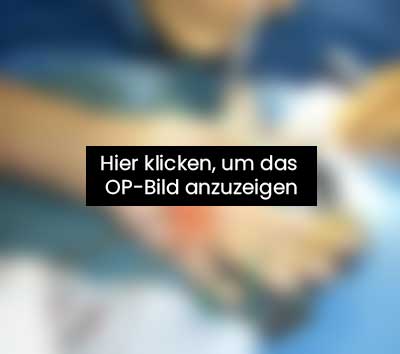Dupuytren’s disease is initially characterized by the formation of coarse cords or nodular changes, usually on the palm of the hand.
Later, an extension inhibition/flexion contracture of the fingers can be observed. The little fingers or ring fingers are most frequently affected. However, Dupuytren’s disease also occurs in the other fingers, including the thumb, where our Düsseldorf hand surgeons can often feel a cord in the first interphalangeal groove, which restricts the spread of the thumb.
The inhibition of finger extension is the result of the benign proliferation of collagen. Similar to excessive scarring, the strands and nodes of Dupuytren’s become harder and harder and eventually contract.
The changes occur in the rather thin fibrous layer (palmar fascia), which is located between the superficial and deep fat layer of the palm and stretches from the wrist to the fingers.
The exact cause of Dupuytren’s disease is unclear. However, it is often inherited. There is also a known connection with liver disease, diabetes and the use of anti-epileptic drugs.
Contents
Yuveo Clinic
Special features of Dupuytren's disease
In the early stages of Dupuytren’s disease, lumps and indurations can be felt; later, in the most severe cases (grade 4), the fingers are completely bent.
Occurring complaints
Cure through surgery?
Dupuytren's contracture
The operation for Dupuytren's disease in Düsseldorf
If Dupuytren’s disease causes symptoms or if there is an incipient curvature of the fingers, surgery should be considered.
If the time is unnecessarily delayed, the operation is usually much more complicated than if our hand surgeons had made a timely diagnosis.
However, it also makes absolutely no sense to remove hardenings that do not cause any discomfort.
Our team of hand surgeons in Düsseldorf will explain the most important strategies to you below.
Minimally invasive partial cord removal as a compromise
Minimally invasive cord removal is less extensive than standard surgery.
We usually make a small incision 1-1.5 cm long under local anesthesia over the cord leading to the contracture.
The Dupuytren’s cord is visualized with magnifying glasses and cut. The hand surgeon then grasps the respective ends and removes as much as possible under vision (usually 1-2 cm in both directions). We can do this in several places. Finally, we suture the incisions.
This surgical technique from hand surgery is particularly suitable in the following cases:
- Slow-growing strands
- Fear of the classic operation
- Desire for the hand to be ready for use quickly
- Moderately severe secondary diseases
- Necessity of blood thinning
However, the hand can be used again much more quickly (usually after 2.5-3 weeks) than with traditional surgery. We operate under visualization so that we can adequately expose and protect nerves, vessels and tendons, even if their position is atypical due to the cord formation.
Overall, we remove significantly less of the altered tissue, which is why an earlier recurrence of contracture must be expected than with classic surgery.
What is the standard operation for Dupuytren’s disease at our clinic in Düsseldorf?
As a hand surgeon, the type and method of surgery for Dupuytren’s disease must be based on the severity of the disease.
While no special features are usually to be expected during surgery in the early stages, the procedure can become very complicated in the advanced stages. Therefore, you should not wait until the final stage for an operation.
Operation in the early stages
If Dupuytren’s disease is not yet too advanced, we can expose and remove the pathologically altered tissue using a zigzag incision. During the operation, our hand surgeons ensure that the nerves and blood vessels in the hand are spared. Even squeezing a nerve too hard with the tweezers can cause permanent damage. In the early and middle stages of Dupuytren’s disease, outpatient surgery in Düsseldorf is possible if there are no other reasons not to do so.
Operation at an advanced stage
In the case of advanced Dupuytren’s disease, we often recommend an inpatient stay at our clinic in Düsseldorf. Sometimes the skin on the flexor side of the fingers has shrunk to such an extent that a regular skin defect is created when the finger is stretched after the cords have been removed. In such cases, we cover the defect by moving the skin or performing a skin graft.
Due to the prolonged flexion position, there may also be pronounced shrinkage of the joint capsules.
By means of joint mobilization (stretching/loosening with the scalpel) we then enable the straightening.
In these cases, it is sometimes necessary to temporarily fix the mobilized finger joint with a wire that we drill through the joint (temporary arthrodesis) in order to prevent the flexion deformity from recurring due to scar shrinkage.
End-stage surgery
The final stage of Dupuytren’s is reached with complete curvature of the fingers and stiffness of the joints. In very rare cases, amputation of a finger may be necessary in such cases, especially if the fingers have already been operated on.
The procedure can be performed under iv. Regional anesthesia with twilight sleep, plexus anesthesia(anesthesia in the armpit) or general anesthesia. If the operation is of medium complexity and there are no reasons (secondary illnesses, extreme findings) to prevent it, we can also perform the operation on an outpatient basis in Düsseldorf with intensive follow-up checks.
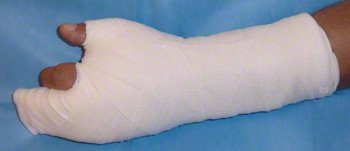
Frequently asked questions about Dupuytren's disease
Is it possible to cure Dupuytren's disease with surgery?
Even if the surgeon is an experienced and meticulous specialist in hand surgery, Dupuytren’s disease cannot be cured by surgery.
Our hand surgeons aim to remove as much of the altered tissue as possible so that it takes years for a lump or cord to reappear.
What is Dupuytren's contracture?
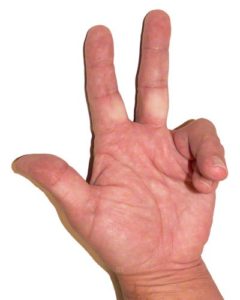
Dupuytren’s contracture is often mentioned in the same breath as Dupuytren ‘s disease. It is a symptom or a finding of Dupuytren’s disease, as contracture means a flexion deformity of the affected fingers.
In the early stages, however, the disease is only noticeable through hardening and nodules(Dupuytren’s nodules), usually in the palms of the hands.
There is no sign of a flexion deformity and the term contracture is simply wrong. Later, these cords can shorten like scars and lead to a restriction in the ability to extend the fingers. This can then be referred to as a contracture, i.e. Dupuytren’s contracture.
Surgery for isolated Dupuytren’s contracture at the Yuveo Clinic Düsseldorf
Before a curvature occurs, stretching exercises can be used to try to counteract the cord.
With further progression, the cords are as tight as wire ropes. A Dupuytren’s contracture can therefore not be stretched.
Strand severance:
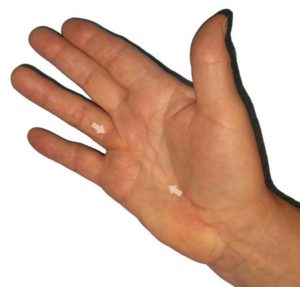
We can operate on an isolated Dupuytren’s contracture (Dupuytren’s cord) in Düsseldorf under local anesthesia. We start with an approx. 1 cm incision, cut the cord under visual control and remove any altered tissue that can be grasped. After the operation, our team of hand surgeons in Düsseldorf recommends intensive stretching exercises.
Strand removal:
Cord removal for Dupuytren’s contracture involves the complete removal of the cord. Larger incisions are required here than for the small operations mentioned above. However, we can remove the diseased tissue far more completely.
What symptoms are typical of Dupuytren's disease?
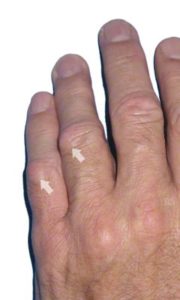
In Dupuytren’s disease, so-called knuckle pads occasionally occur on the extensor side of the fingers. Here in the picture on the middle joints of the ring finger and little finger.
At the beginning, Dupuytren’s disease does not cause any symptoms. Only slight nodular or cord-like indurations can be felt in the palm. However, the nodular changes in the palm can cause symptoms even if they are still mild. Firm gripping then causes moderate but annoying pressure pain.
In the later course of the disease, these changes spread further and lead to flexion deformity, usually of the little finger and/or ring finger. As already described, the other fingers and the entire palm can be affected.
In the final stage, the fingers rest against the palm and can no longer be moved.
However, the main problem is the restriction of finger extension. The patient’s hand often gets caught (e.g. on the edge of a trouser pocket or on bags). Furthermore, the gripping function of the hand is significantly restricted in terms of strength development and fine motor skills. Grip insecurity also increases the risk of accidents.
What is the follow-up treatment after a Dupuytren operation in Düsseldorf?
The follow-up treatment for Dupuytren’s disease depends on the extent to which we had to operate.
Easy cases
In mild cases, you will be able to carry out independent movement exercises with stretching exercises after just a few days.
Moderate and severe cases
After surgery for high-grade findings, the surgical result can be maintained and healing accelerated by the following measures:
Physiotherapy: Improving the range of motion, ensuring the tendons can glide and the joints can move.
Occupational therapy: The main focus, however, is on the rapid recovery of function and coordination. In addition, the regeneration of affected nerve fibers is promoted (= sensorimotor-perceptive treatment).
Lymphatic drainage: Supports the drainage of lymphatic fluid in the event of lymph congestion after the procedure.
Scar massage: Supporting the softening of scarring in the tissue and preventing scar contractures.
Dynamic or static finger splints: Prevent / reduce excessive shrinkage of the scars after surgery on very advanced Dupuytren’s findings.
Fact check
- 1.5-2 million Germans are affected by Dupuytren’s disease.
- The disease occurs more frequently in men than in women.
- Dupuytren’s disease is most common in the 4th and 5th decade of life.
- Duputren’s disease can be associated with other fibromatoses.
- Only isolated cases are known among Asians and Africans.
- You will be treated by your surgeons Dr. Schumann and Dr. Schumann-Averkiou.
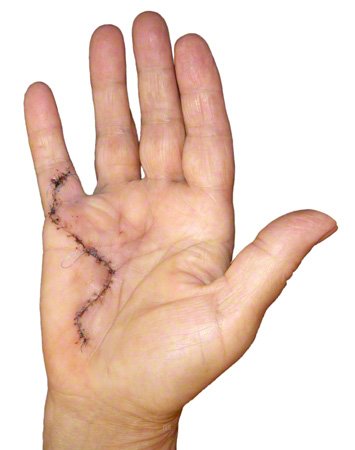
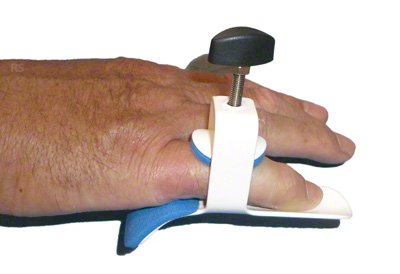
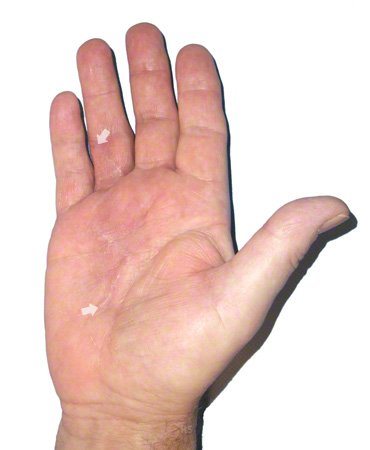
Further information and related topics
Technical terms:
The following synonyms are common: Dupuytren’s contracture, fibromatosis of the palmar fascia, palmar fibromatosis (palm = palm of the hand)
Further information:
- Is radiotherapy an option for Dupuytren’s disease?
- Is conservative treatment possible?
- Interesting facts about the history
- Where else can fibromatosis occur?
- Y-V plastic
- Z-plastic
Informative sources:

